Guiney, Ciara (2017) Trends in recorded drug law offences 2003—2016. Drugnet Ireland, Issue 63, Autumn 2017, pp. 22-23.
| Preview | Title | Contact |
|---|---|---|
|
PDF (Drugnet Ireland 63)
1MB |
This article examines trends in drug law offences between 2003 and 2016. Crime data, which are collated on the PULSE system by An Garda Síochána, are provided to the Central Statistics Office (CSO) for analysis. An incident may consist of more than one criminal offence. A primary offence or detection may refer to one offence within an incident. Sometimes, a charged offence may be different from the offence originally identified in the incident. Nevertheless, incidents are a useful indicator of the level of particular types of criminal activities.1 Figure 1 shows the available statistics for recorded incidents of drug offences between 2003 and 2016, as entered on the PULSE system by Gardaí.
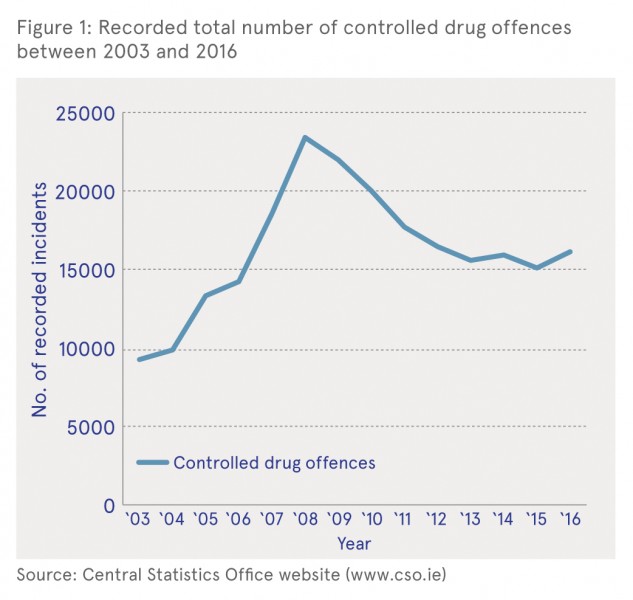
Recorded incidents of drug offences
Figure 1 provides a summary of the total number of controlled drug offences recorded by Gardaí. Following a decline between 2008 and 2013, the total number of controlled drug offences recorded in Ireland increased in 2014 (4%). Although a decline of 5% (15,915 to 15,090) was recorded between 2014 and 2015, the number of offences recorded increased by 7% between 2015 and 2016.2 Further insight can be obtained by examining recorded incidents for supply (importation and cultivation/manufacture of drugs) and possession (sale or supply or personal use) offences separately.
Supply
Figure 2 shows a breakdown of the number of controlled drug offences by importation or by cultivation or manufacture of drugs recorded between 2003 and 2016.
Importation of drugs
Essentially, between 2003 and 2016 an increase/decrease trend has been evident for recorded importation of drugs incidents. Increases were seen between 2005 and 2008 (86%), 2010 and 2011 (41%), 2012 and 2013 (47%), and 2015 and 2016 (40%). Decreases were seen from 2008 to 2010 (-57%), 2011 to 2012 (-27%), and 2013 to 2015 (-55%).
Cultivation or manufacture of drugs
Recorded incidents for the cultivation or manufacture of drugs increased between 2003 and 2011. The increase each year between 2006 and 2010 was substantial. Between 2011 and 2015, there was a steady decline in the number of such incidents reported; 2015 figures were nearly 60% lower than 2011. Between 2015 and 2016, recorded incidents increased by 10% (see Figure 2).
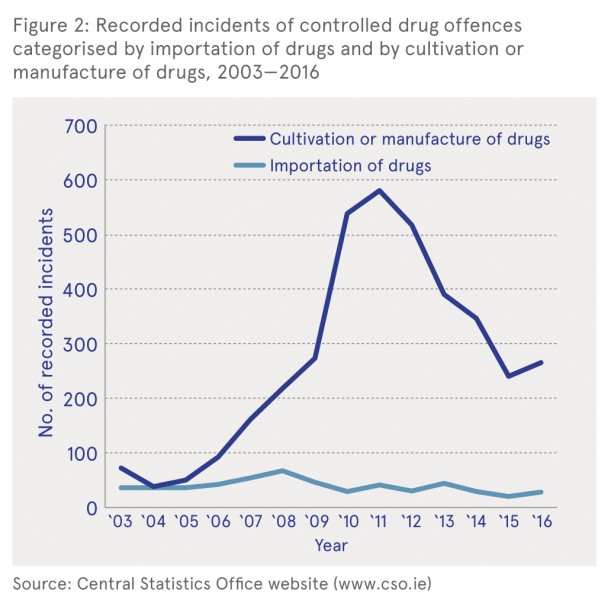
Possession of drugs
Figure 3 shows the number of recorded incidents for possession of drugs for sale or supply and for personal use.
Sale or supply
Although the number of recorded offences for possession of drugs for sale or supply increased between 2004 and 2008, a steady decline was seen between 2008 and 2013. Since 2013, the number of incidents recorded increased by 10% in 2014, decreased in 2015 (6%), and increased again in 2016 (9%).
Personal use
The number of incidents recorded for possession of drugs for personal use increased between 2003 and 2008. A decreasing trend was seen between 2008 and 2013. Since 2013, incidents recorded for possession of drugs increased in 2014 (<1%, 85), decreased in 2015 (3%, 317) and increased again by 5% (530) in 2016 (see Figure 3).
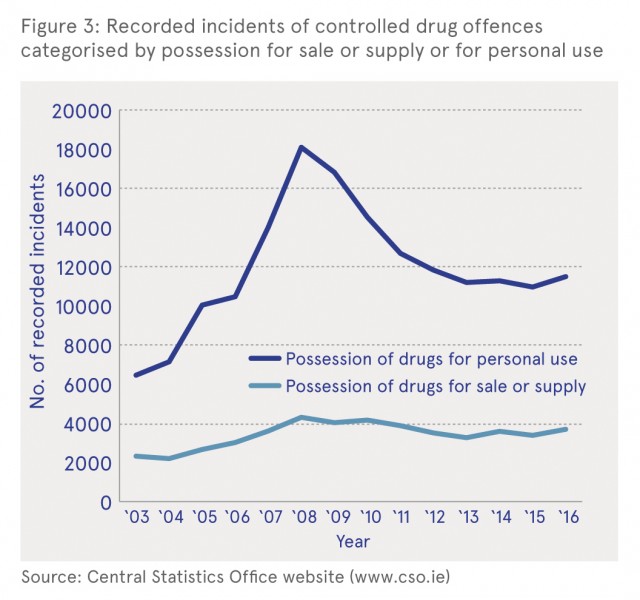
Other drug offences
The category ‘possession/supply drug offences, drug-related crime’ also has a classification for other drug offences, which includes forged or altered prescription/obstruction offences.
Forged or altered prescription/obstruction under the Misuse of Drugs Acts 1977—2016
Although a substantial decrease (28%) was shown in this category between 2014 (681) and 2015 (494), crimes recorded increased by 24% (157) to 651 in 2016 (see Figure 4).
Driving under the influence of drugs
Driving under the influence of drugs has been a statutory offence in Ireland since the enactment of the Road Traffic Act 1961.3 A decreasing trend for this offence has been evident since 2009, and continued in 2016 (see Figure 4).2
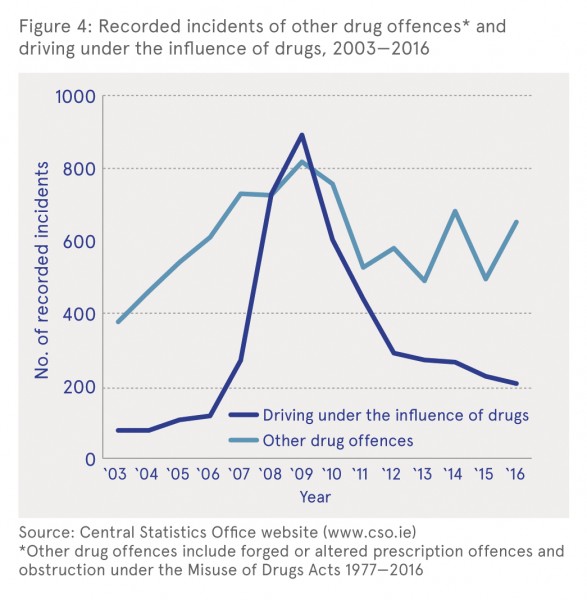
Detected drug offences 2010 and 2014
Court proceedings statistics shed light on the level of recorded incidents that become detected crimes, i.e. a crime that has been solved by An Garda Síochána. The most recent available data are for 2010 to 2014 (see Figure 5). The number of offences detected decreased between 2010 and 2013 by 23%. Between 2013 and 2014, detections increased slightly by just over 3%. Notably, an examination by region indicates that, although detected offences are dispersed throughout the island of Ireland, the majority of detections (45%) occur in the Dublin Metropolitan Region followed by the Southern Region (17%) representing Cork City, Cork North, Cork West, Kerry, Limerick (see Figure 6).
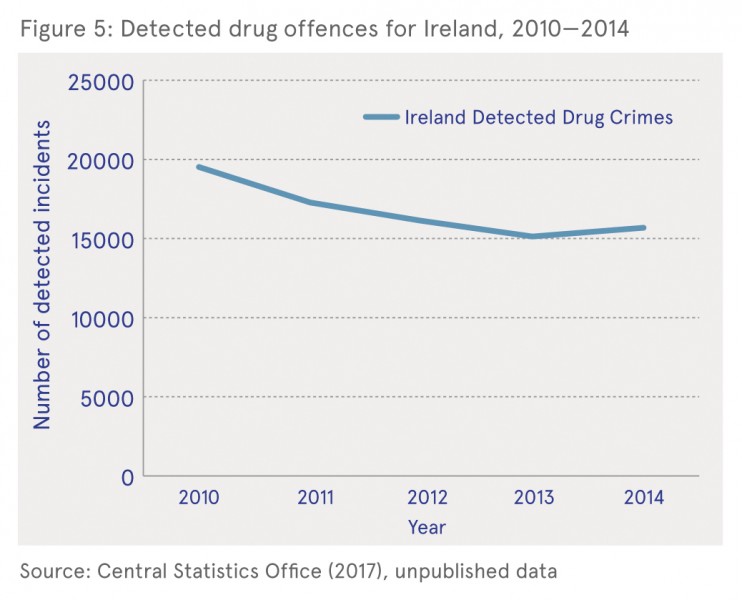
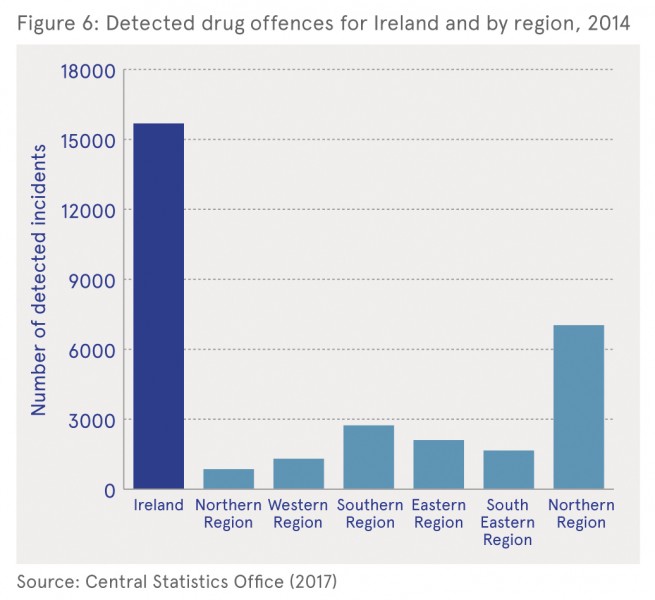
1 Central Statistics Office (2014) Interpreting crime statistics: a background briefing note. https://www.drugsandalcohol.ie/24806/
2 Central Statistics Office (2017) Crime and justice statistics. Available online at http://cso.ie/en/statistics/crimeandjustice/
3 Road Traffic Act 1961. Available online at http://www.irishstatutebook.ie/eli/1961/act/24/enacted/en/html
MM-MO Crime and law > Crime > Substance related crime > Crime associated with substance production and distribution
MM-MO Crime and law > Substance related offence > Drug offence > Illegal production of drugs
MM-MO Crime and law > Substance related offence > Drug offence > Illegal transportation of drugs (smuggling / trafficking)
MM-MO Crime and law > Substance related offence > Drug offence > Illegal distribution of drugs (drug market / dealing)
MM-MO Crime and law > Substance related offence > Drug offence > Illegal drug possession (seizures)
MM-MO Crime and law > Crime and violence > Crime against persons (assault / abuse)
MM-MO Crime and law > Substance use laws > Drug laws
VA Geographic area > Europe > Ireland
Repository Staff Only: item control page